By MB
Article 1 of the Declaration on Women’s Sex-Based Rights reaffirms that the rights of women are based on sex; not gender or gender identity. The Article calls for the retention of the definition of ‘woman’ as an adult human female in all actions of the State. It emphasizes that women are discriminated against based on sex - the biological fact that they are female. This recognition of what constitutes discrimination against women is essential to uphold women’s human rights such as (but in no way limited to) the right to safety from male violence, for example. The loss of it in favor of gender identity- an ambiguous terminology based on individual feeling, leads to the inclusion of male-bodied persons in the laws and policies meant for the advancement of women. This means men (adult human males) getting access to women’s prisons, elected to seats reserved for women and competing in women’s sports. The essence of Article 1 is that the mere inclusion of men claiming to be women in the legal definition of ‘woman’ constitutes discrimination against women.

Source: link
Article 15 of the Constitution of India prohibits discrimination by the State on the basis of ‘sex’. The Constitution does not use the word ‘gender’, which could be defined as social roles, stereotypes and behaviors expected of the members of a particular sex; thereby confirming that the law acknowledges the difference between sex and gender. But the Transgender Persons (Protection of Rights) Act, 2019 does away with the difference between sex and gender by defining a transgender person as someone whose, “gender does not match with the gender assigned to that person at birth…”
According to the UNFPA, 142.6 million females in the world are ‘missing’ (a term used to signify absence, death, murder or otherwise) due to families preferring sons over daughters. Indian females make up 45.8 million of this figure. These girls are ‘missing’ not because of any innate feeling; but because they are female and hence unwanted. This Indian reality quintessentially underpins the foundational idea of Article 1 - that women are oppressed on the basis of sex and not ‘feeling.’
The replacement of sex with gender identity would lead to the erosion of, among other things, Indian women and girls’ right to safety from the pervasive threat of male violence. Male violence against women in India is widespread: rape, prostitution, sexual harassment, acid attacks or domestic violence (highest number of complaints recorded this year since 2000).
A common example is the women-only compartment in metro trains and buses. Women have acknowledged that these spaces have offered them freedom of movement unobstructed by male aggression. Women have also fought for decades to secure reserved seats for female only candidates in the village Panchayat elections. This is to ensure women’s political participation, and the needs of the women in the constituency are being taken care of. However, the struggle to achieve equal political participation for women continues; especially against the entrenched caste system that prevents women of the marginalized communities from becoming independent leaders. With self-ID, males have managed to contest under women’s quotas; pushing women out of policies made specifically for them.
The 1.4 million Anganwadi workers of India are an all-female force who provide nutrition, education, and health services to women and children in rural India. It is crucial to emphasize that the Anganwadi - an exclusively women-run scheme - is no small matter. The Anganwadi is a source of employment for rural women; and the first point of access to formal healthcare for women who are deprived of socio-economic means. Any inclusion of males either as Anganwadi workers or as beneficiaries carries the inevitable risk of jeopardising the safety of females who depend on the Anganwadi.
Regressively, the state of Kerala has started a campaign to achieve “gender equality” which includes training Anganwadi workers on “gender identity.”
Indian women are treated like chattel; undermined, neglected, violated and murdered not because they ‘feel’ like women-- but because they are singled out for their femaleness and placed at a social disadvantage from men. That is why women-only spaces, policies, affirmative action, legislation or schemes are not “cisgender privilege,” they are our civil and political rights as citizens. So women should not be made to give them up to accommodate men’s feelings and desires.
Female erosion in India has already begun and women are now being told that men can menstruate, men can identify as mothers, and the movement meant for reproductive rights of women have become “gender-neutral,” lest the thousands of other ‘genders’ be left out.
In reaffirming the sanctity of the female body as a material reality, Article 1 provides a counter to the misogynistic prevalent wave of gender identity in India.